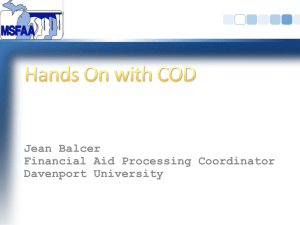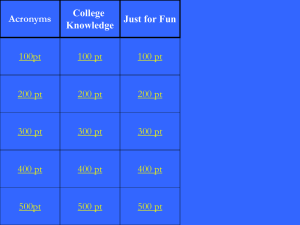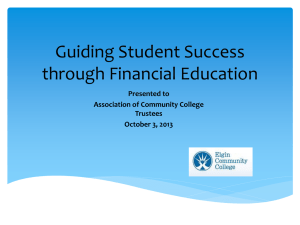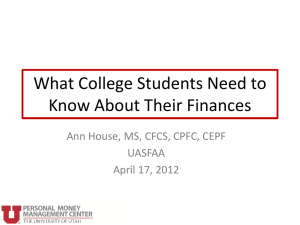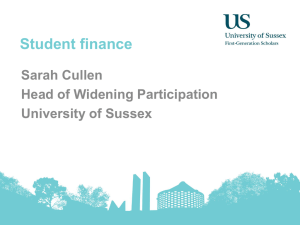Direct Loans & Loan Counseling
advertisement
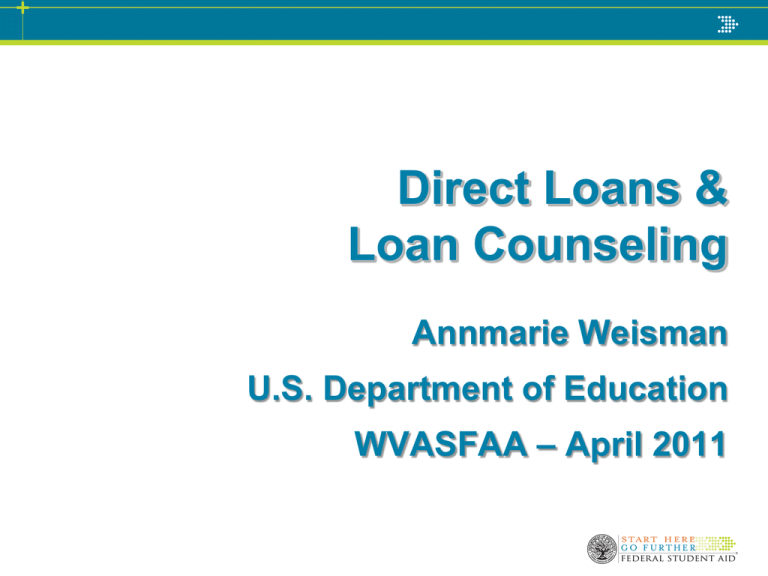
Direct Loans & Loan Counseling Annmarie Weisman U.S. Department of Education WVASFAA – April 2011 Direct Loan Basics Direct Loan Basics • Loan types • Loan amounts and limits • Interest rates • Loan counseling • Master Promissory Note Direct Loan & FFEL • Same regulations related to – Student Eligibility – Loan periods – Annual loan limit progression – Disbursement – Borrower’s right to cancel – Credit balances – Prior year charges – R2T4 Disbursement Process • Funding Source - Single source of DL funds – U.S. treasury - Current Funding Level provided in G5 • School must calculate and draw funds for immediate need from G5 - Funds drawn in lump sum, not student specific Origination • Origination is the Direct Loan equivalent of FFEL certification • Similar to originating Grants in COD - Confirm eligibility - Determine award/loan amount - Loan Origination Record sent to COD - Contains person data + DL Award + anticipated disbursement dates and amounts Disbursement Reporting To COD • Actual disbursement date and amount – Report up to 7 days before the actual date of disbursement – Report no later than 30 days of crediting the student’s account • Interest begins to accrue on actual disbursement date reported by school; must report correct date Different “Years” Used for DL • Award Year – Use of ISIR/EFC • If loan period is wholly contained within the award year, use ISIR/EFC associated with that award year • If loan period contains both June 30 and July 1 (a crossover period), school may use the ISIR/EFC from either award year – In G5, identify which year’s funds are being used – Unlike other Title IV programs, more loan funds do not become available at start of new award year Different “Years” Used for DL • Defined Academic Year (AY) for Title IV – Typically this is the loan period used for DL – Can be a lesser period for programs shorter than an AY or for periods of study extending beyond one AY but do not extend to two AYs • Used slightly differently with Scheduled Academic Year (SAY) vs. Borrower-Based Academic Year (BBAY) Different “Years” Used for DL • Scheduled Academic Year (SAY) – Is the defined AY with any summer term added to it as a trailer or header or – Is the defined AY which includes all terms in the calendar year including summer • An SAY is a fixed period of time that begins and ends at the same time each year Different “Years” Used for DL • Borrower-Based Academic Year (BBAY) – The loan period is the defined AY or – For a program that is less than an AY, the loan period is the length of the program* or – For a program longer than an AY, but shorter than two AYs, the period of study that remains after the first loan period is the second loan period* * Loan proration required Loan Periods & Disbursements Standard Terms • Minimum loan period is the academic term • Maximum loan period is the academic year • Disbursement – One term loan period • Two substantially equal disbursements • Second not before calendar midpoint of term – Multiple term loan period • Disburse by term in substantially equal disbursements Nonstandard-Terms • Substantially equal terms, where each is at least 9 weeks in length (NS-SE9W) – Loan period is one term or multiple terms – Disburse by term, in substantially equal disbursements Nonstandard-Terms NS-NSE or NS-SEL9W • Loan Period – Minimum loan period is lesser of • Program length • Academic year (AY) • Remainder of program if less than one AY • Remainder of AY for transfer student with accepted hours – Maximum loan period is the academic year • May be greater than 12 months Nonstandard-Terms • NS-NSE Disbursements – Must disburse in 2 equal disbursements – Second disbursement after successful completion of half of hours in period and half of weeks have elapsed • NS-SEL9W Disbursements • Disburse by term in substantially equal disbursements Clock hour/Nonterm Credit Hour • Minimum loan period is lesser of - Program - Academic year (AY) - Remainder of program if less than one AY - Remainder of AY for transfer student with accepted hours • Maximum loan period - Academic year • May be greater than 12 months Clock hour/Nonterm Credit Hour • Disbursement is by payment period – First disbursement may be no earlier than 10 days before beginning of payment period – Second disbursement is at later of • Successful completion of half of clock hours in loan period or • Half of weeks of instructional time in loan period have elapsed Transfer/Program Change Clock Hour/Nonterm Credit Hour • Student transfers to new school with accepted hours – New loan may be originated for remaining portion of program or academic year • Student completes program and begins new program at same school during same academic year – New loan may be originated for remainder of academic year in first program Monitoring Annual Loan Limits Monitoring Annual Loan Limits • Scheduled Academic Year (SAY) • Used by term-based credit-hour programs - Fixed period of time that begins and ends at same time each year - Must contain number of terms in academic year Monitoring Annual Loan Limits Borrower-Based Academic Year (BBAY) • Not fixed, but moves with student’s attendance and progression in program – May be used by term-based credit hour programs that have a Scheduled Academic Year (SAY) – Must be used for clock-hour, nonterm credit hour, and NS-NSEL9W programs Annual Loan Limit Progression • Standard Terms & NS-SE9W – Student is considered to have completed an academic year and progresses to the next annual loan limit when the academic year calendar period has elapsed. • May use SAY or BBAY SAY for Semester or Trimester-Based Program 2-Year Credit-Hour Program Academic Year 24 Credits/ 30 Weeks Fall Spring Fall Spring 1st SAY 2nd SAY $5,500 annual loan limit $6,500 annual loan limit SAY With Summer As Trailer 2-Year Credit-Hour Program Academic Year 24 Credits/ 30 Weeks Fall Spring 1st SAY $5,500 annual loan limit Summer Trailer to SAY Remaining eligibility assuming same grade level is $5,500 – Amount Borrowed in Fall/Spring SAY for NS-SE9W 2-Year Credit-Hour Degree Program Academic Year of Four 9-Week Modules Mod 1 Mod 2 Mod 3 Mod 4 1st SAY $5,500 annual loan limit Mod 5 Mod 6 Mod 7 2nd SAY $6,500 annual loan limit Mod 8 BBAY for Semester or Trimester-Based Program 2-Year Credit-Hour Program Academic Year 24 Credits/30 Weeks Fall Spring 1st BBAY $5,500 annual loan limit Summer Fall 2nd BBAY $6,500 annual loan limit BBAY for NS-SE9W 2-Year Credit-Hour Degree Program Academic Year of Four 9-Week Modules Student has transfer credit that fulfills Module 1 so he begins with Module 2 Mod 2 Mod 3 Mod 4 Mod 5 1st BBAY $5,500 annual loan limit Mod 6 Mod 7 Mod 8 2nd BBAY $6,500 annual loan limit Must be prorated because is final period of study less than an academic year Annual Loan Limit Progression • NS-NSE & NS-SEL9W – Student is considered to have completed an academic year and progresses to the next annual loan limit at the later of • Student's completion of the weeks of instructional time in academic year or • Date determined by school, that student has successfully completed academic coursework in academic year Annual Loan Limit Progression • Clock Hour/Non-Term Credit Hours – Student is considered to have completed an academic year and progresses to the next annual loan limit at the later of • Student's completion of weeks of instructional time in academic year or • Date determined by the school, that student has successfully completed the clock hours in academic year BBAY – Clock-Hour Program 1200 Clock-Hour/32 Week Program 900 Clock-Hour/26 Week AYD 450 hrs/13 wks 450 hrs/13 wks 1st BBAY $5,500 annual loan limit *Must 300 hrs/6 wks 2nd BBAY $6,500 annual loan limit* prorate annual loan limit for final period less than an academic year $4,500 x 300 / 900 = $1,500 Sub $2,000 x 300 / 900 = $667 Unsub Reconciliation Reconciliation • A General Definition - The process by which records from one system are compared to records from another, and any discrepancies are identified and resolved. - Balancing a checkbook would be an example Reconciliation: Three Key Systems Financial Aid Office Business Office 5 G COD Direct Loan Reconciliation •Process by which the Direct Loan Cash Balance recorded on the Department of Education system is reviewed and compared with a school’s internal records on a monthly basis. The school must: - identify and resolve discrepancies, and - document reasons for their Ending Cash Balance Ending Cash Balance (ECB) Total Net Drawdowns –Total Net Booked Disbursements Ending Cash Balance Program Year Closeout •Process by which schools complete final processing at the end of a Direct Loan award year. - Extension of the monthly reconciliation process - $0 Ending Cash Balance DL funds received = DL funds disbursed) - Final deadline: Last processing day of July at the following end of the following award year (7/29/2011 for 2009-2010). Note: 30 Day reporting requirement supersedes both reconciliation and closeout requirements Tools and Resources • School Account Statement (SAS) • COD Website • DL Tools • Student Files • Financial Aid Office Reports • Business Office Reports Monthly Reconciliation Other Reports and Tools • 30 day Warning Report (COD) • Booked Status Report (EDExpress or custom) • Pending Disbursement List (EDExpress List – Anticipated Disbursements, Pending Actual Disbursements) • Funded Disbursement List (EDExpress List – Actual Disbursements, Booked and Unbooked) • Disbursement Measurement Tool Report (DL Tools) • Cash Summary Report (DL Tools – optional) • Ledgers, Bank Statements, Cancelled Checks • Other Internal School Reports COD Customer Service • COD Customer Service – Customer Service Representative – Weekly monitoring e-mails – Reconciliation Team • 1-800-848-0978 • https://cod.ed.gov Entrance Counseling StudentLoans.gov Entrance Counseling Tool StudentLoans.gov Entrance Counseling can be completed through StudentLoans.gov What Will the Borrower Experience Using the Entrance Counseling Tool? Through the StudentLoans.gov Entrance Counseling process, borrowers will learn about • Direct Loans • Rights and responsibilities as a borrower • Managing educational expenses • Other financial resources to consider that may help pay for the borrower’s education Select Counseling Type Borrowers are prompted to select the counseling type (undergraduate or grad/ professional Student Selects Schools To Receive Data Borrower can select up to three schools to send the Entrance Counseling data Topics Include • Borrower will complete a short training session on a variety of Direct Loan related topics including – Types of Loans – Borrow Wisely – You Must Repay – MPN – Loan Limits – Interest Rates Topic Screen Borrowers will complete a training session on a series of topics Site Includes Quiz At the end of each topic, the borrower must complete several quiz questions Student Can Print Confirmation StudentLoans.gov Alerts COD • Once a borrower completes an Entrance Counseling session on the StudentLoans.gov website: • Completed Entrance Counseling data is submitted to COD • Entrance Counseling Acknowledgement is sent to schools • Schools can search COD for completed Entrance Counseling sessions Schools Can Search For Entrance Counseling Data In COD • SSN • Entity ID • Date Range • Counseling Type • Award Year StudentLoans.gov Planned Enhancements • COD Release 10.0 (February 18, 2011) • New Entrance Counseling Report – Generated weekly – Includes completed Entrance Counseling from the previous week – Available via the COD Reporting website in CSV format with headers • COD Release 10.1 (June 17, 2011) • Ability to complete Entrance Counseling in Spanish on StudentLoans.gov NSLDS Exit Counseling NSLDS—Exit Counseling • Benefits for Students – Students who link to counseling session on studentloans.gov site are directed to NSLDS – Single exit counseling tool for all • Borrowers with: DL, FFEL, DL & FFEL – Secure login process • Students: www.nslds.ed.gov – Introduces NSLDS to student before repayment NSLDS—Exit Counseling Benefits for schools: • Helps to meet regulatory requirements – For use with DL & FFEL programs – Data sent automatically to GAs & ED Servicers – Includes borrower’s actual loan data • Flexible reporting options – Login at www.nsldsfap.ed.gov • Automatic update of completion date for EDExpress users NSLDS—Exit Counseling Provides: – Actual loan balance – Repayment Information – Estimated monthly payments – Budget worksheet – Quiz to enhance comprehension Collects: – – – – Student contact info Future Employer Next of Kin References NSLDS--Exit Counseling Complete on Student site www.nslds.ed.gov Start–Fulfills exit counseling requirement Tour–Browse/Review content (both available for Student and FAAs) Click the link for the Spanish version NSLDS—Exit Counseling Same login as other FSA sites for students: •SSN •Name ID •DOB •FSA PIN NSLDS—Exit Counseling Repayment Options page displays: •Sample information for various debt amounts •Monthly and Total Payments under different Repayment Plans •Payment estimates with and without loan consolidation • Message confirms student completion • Schools can view on NSLDSFAP website NSLDS—Exit Counseling Contacts for Students Contacts for Schools Federal Student Aid Information Center NSLDS Customer Support Center 800-433-3243 800-999-8219 Outside U.S. (Toll call) 319-337-5665 Outside U.S. (Toll call) 785-838-2141 Your Region III Training Team • Greg Martin, Training Officer – 215-656-6452 – gregory.martin@ed.gov • Craig Rorie, Training Officer – 215-656-5916 – craig.rorie@ed.gov • Annmarie Weisman, Training Officer – 215-656-6456 – annmarie.weisman@ed.gov 62 Contact Information • If you have follow-up questions about this session, contact me at: – Annmarie Weisman, Training Officer – annmarie.weisman@ed.gov – 215-656-6456 • To provide feedback to my supervisor: – Tom Threlkeld, Supervisor – thomas.threlkeld@ed.gov – 617-289-0144 63

